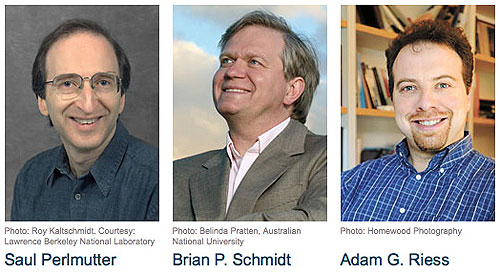
Can you name 5 Nobel Laureates? It turns out not many people can answer this question. The works of Nobel Laureates are quite remarkable and they make great contributions to society’s collective understanding. Therefore, I feel it is important that I remain aware about the news of the Nobel world, in particular the prize in physics. So let me share with you some fascinating information about this year’s Nobel Winners in Physics and their mind blowing work. It’s literally bigger than anything in the entire universe.
The Nobel Prize in Physics were awarded one half to Saul Perlmutter (UC Berkeley) and the second half jointly to Brian Schmidt (Australian National University) and Adam Riess (Johns Hopkins University) for the discovery of the accelerating expansion of the universe.

It is almost widely known that the universe has been expanding for the last 5 million years. Space itself has been stretching and expanding. Imagine a balloon that has been partially blown up, with the surface representing our universe. If you draw dots with a marker on various locations of the surface, and you blow the balloon again, you will find that the marks are further apart from each other than they were initially. The space between them has expanded. This is the same thing that is happening to our universe. The space between our galaxy and all other galaxies are stretching and we are getting further away from each other. You may ask why is it that we do not notice this stretching on Earth? Locally, the stretching is so small and insignificant that it cannot be noticed. But since the universe is very large, over a lot of space all these contributions add up and become noticeable (think calculus).
Naturally, the second question would be to ask, “How fast is it expanding or how fast is the expansion slowing down?” which was exactly what Perlmutter, Schmidt, and Reiss sought to answer. It was believed that the expansion rate would slow down as the amount of matter accumulates in the universe and as the strength of gravity increases, the inward pull of gravity would slow down the expansion, eventually to a stop, and if powerful enough, revert the expansion and cause the universe to collapse in on itself in a Big Crunch.
The three measured this by using the brightness of Type IA supernovas (explosion of stars near the end of their lifetime) which are explosions of white dwarf stars. They also used the redshift of these stars to determine how fast they were moving away from the Earth. With these two pieces of information, they would be able to determine how fast the universe is accelerating. But their results showed that the brightness that they observed was less than what they expected, which meant that the universe’s expansion is not slowing down, but speeding up. Space itself was getting stretched faster. The laureates were actually on competing teams attempting to answer the same question, Perlmutter on one team and Schmidt and Riess on the other. Their results were so astonishing that the two teams needed to confirm each other’s results in order for it to be accepted by the scientific community.


The result of the accelerating expansion of the universe carries enormous implications. As space expands, the distance between galaxies are expanding faster and faster too. Galaxies are rushing away from us so quickly than in the distant future, their light will not even be able to reach the Earth. The universe will become a cold dark and lonely place and future astronomers will only be aware of the existence of other galaxies by the textbooks that described them in the past. The universe will not end in a Big Crunch, but a Big Rip as the expansion rate speeds out of control and rips the fabric of space time. Like a balloon being filled too quickly until the rubber membrane which holds its form tears.

Aside from this morbid interpretation, their work has also opened the doors to exciting new questions and discoveries in physics. For example, the real question was, what is driving this accelerating expansion? There must be some kind of energy in the vacuum of space that is counter-acting the inward pull of gravity, and this energy must be a lot stronger than all of the gravity in the universe. As a placeholder for this mysterious energy, physicists have dubbed it Dark Energy. Dark Energy makes up 75% of the entire universe. Another 20% is to another mysterious substance called Dark Matter, and the last 5% is to all physical matter. That means the total material composition of the stars, galaxies, planets only make up a small fraction of the composition of the entire universe. Physicists don’t know what is Dark Energy, and they cannot see it (hence ‘Dark’), but they know it’s there.
The work of Perlmutter, Schmidt, and Reiss has changed our outlook on the universe. Whether their work will have any practical applications in our life is not explicit. But the spirit of science is not to make a profit off our power to manipulate nature. It is about the quest to understanding nature through reasoning, experimentation, and asking questions. Perlmutter, Schmidt, and Reiss have certainly given us some fun questions to think about. Congratulations to the Nobel Laureates.
In my next post, I will explain in a bit more detail the actual science behind the work.
VIDEO: Dark Matter

